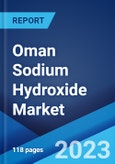The Oman sodium hydroxide market size reached 168,700 Tons in 2022. Looking forward, the publisher expects the market to reach 214,650 Tons by 2028, exhibiting a growth rate (CAGR) of 3.8% during 2023-2028.
Caustic soda, also known as sodium hydroxide (NaOH), refers to an inorganic compound which comprises sodium cations Na+ and hydroxide anions OH-. It is industrially prepared through the electrolytic chlor-alkali process in which electrolysis of aqueous sodium chloride solution produces chlorine gas and sodium hydroxide. It is an odorless and non-flammable white solid which is commercially available in the form of flakes, pellets, granules and aqueous solutions of different concentrations.
Major factor driving the market of sodium hydroxide in Oman region is increasing use of NaOH in number of industries including chemical, automotive, water treatment, and food and beverage. Oman being one of the Gulf region’s fastest growing economies has growing industries in this region therefore accelerated the demand of caustic soda in this region. Moreover, on account of its easy availability and affordability over its substitutes, it is regarded as one of the preferred chemical compounds employed to control acidity and remove heavy metals from water. Moreover, NaOH costs less than its alternative available which is potassium hydroxide. Therefore, it is economical to use sodium hydroxide than its alternative. It is available commercially in various forms such as liquid, solid, flakes, or particles. Wide accessibility and availability of the product in Oman region has further driven the market of NaOH. Caustic soda is also used in the production of paper wherein it helps in dissolving unwanted compounds present in the wood pulp. Omani government is facilitating tax incentives and credit approvals, and also making amendments in policies in order to attract foreign direct investments.
Caustic soda, also known as sodium hydroxide (NaOH), refers to an inorganic compound which comprises sodium cations Na+ and hydroxide anions OH-. It is industrially prepared through the electrolytic chlor-alkali process in which electrolysis of aqueous sodium chloride solution produces chlorine gas and sodium hydroxide. It is an odorless and non-flammable white solid which is commercially available in the form of flakes, pellets, granules and aqueous solutions of different concentrations.
Major factor driving the market of sodium hydroxide in Oman region is increasing use of NaOH in number of industries including chemical, automotive, water treatment, and food and beverage. Oman being one of the Gulf region’s fastest growing economies has growing industries in this region therefore accelerated the demand of caustic soda in this region. Moreover, on account of its easy availability and affordability over its substitutes, it is regarded as one of the preferred chemical compounds employed to control acidity and remove heavy metals from water. Moreover, NaOH costs less than its alternative available which is potassium hydroxide. Therefore, it is economical to use sodium hydroxide than its alternative. It is available commercially in various forms such as liquid, solid, flakes, or particles. Wide accessibility and availability of the product in Oman region has further driven the market of NaOH. Caustic soda is also used in the production of paper wherein it helps in dissolving unwanted compounds present in the wood pulp. Omani government is facilitating tax incentives and credit approvals, and also making amendments in policies in order to attract foreign direct investments.
Key Market Segmentation:
The publisher provides an analysis of the key trends in each segment of the Oman sodium hydroxide market report, along with forecasts for the period 2023-2028. The report has categorized the market based on end use, form and application.Breakup by End Use:
- Aluminium Processing
- Pulp and Paper
- Textile
- Soaps and Detergents
- Petroleum
- Chemical Processing
- Others
Breakup by Form:
- Liquid
- Solid
Breakup by Application:
- Cleaning Agent
- Catalysts
- Additives
Competitive Landscape:
The report has also examined the competitive landscape of the Oman sodium hydroxide market.Key Questions Answered in This Report:
- How has the Oman sodium hydroxide market performed so far and how will it perform in the coming years?
- What has been the impact of COVID-19 on the Oman sodium hydroxide market?
- Which are the key forms in the Oman sodium hydroxide market?
- What are the major application segments of Oman sodium hydroxide market?
- What are the major end-use industries in the sodium hydroxide market in Oman?
- What has been the prices of sodium hydroxide in Oman and how will the prices change in the coming years?
- What is the structure of the Oman sodium hydroxide industry and who are the key players?
- What are the key driving factors and challenges in the Oman sodium hydroxide industry?
- What is the degree of competition in the Oman sodium hydroxide industry?
Table of Contents
1 Preface3 Executive Summary13 Profiles of Key Players
2 Scope and Methodology
4 Introduction
5 Oman Sodium Hydroxide Market
6 Consumption Breakup by End-Use
7 Consumption Breakup by Form
8 Consumption Breakup by Application
9 Price Analysis
10 Key Buyers & Purchasing Criteria Analysis by Industry
11 Competitive Landscape
12 Key Industry Dynamics
Methodology

LOADING...
Table Information
| Report Attribute | Details |
|---|---|
| No. of Pages | 118 |
| Published | September 2023 |
| Forecast Period | 2022 - 2028 |
| Estimated Market Value in 2022 | 168700 Tons |
| Forecasted Market Value by 2028 | 214650 Tons |
| Compound Annual Growth Rate | 4.1% |
| Regions Covered | Oman |









